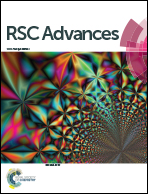Novel mononuclear ruthenium(ii) complexes as potent and low-toxicity antitumour agents: synthesis, characterization, biological evaluation and mechanism of action
Abstract
The ruthenium complex is considered a potential agent that could avoid the side-effects and chemoresistance of platinum-based anti-cancer drugs, such as cisplatin, carboplatin or oxaliplatin. In our study, three novel mononuclear ruthenium(II) complexes with salicylaldehyde as an ancillary ligand, [Ru(bpy)2(salH)]PF6 (Ru-1), [Ru(dmb)2(salH)]PF6 (Ru-2) and [Ru(phen)2(salH)]PF6 (Ru-3), where bpy = 2,2′-bipyridine, dmb = 4,4′-dimethyl-2,2′-bipyridine, phen = 1,10-phenanthroline, and salH = salicylaldehyde, have been synthesized, characterized and evaluated in vivo and in vitro. We showed that Ru-2 effectively blocked DNA synthesis and induced cell apoptosis by interacting with double-stranded DNA. More significantly, Ru-2 showed excellent antitumour effects in a cellular study (IC50 values of 3.60 μM for BGC823 human gastric cancer cells in vitro) and a xenograft model (inhibited tumour growth by 46%) at a dose of 5 mg kg−1 and exhibited insignificant hepatotoxicity and nephrotoxicity compared with a 4 mg kg−1 cisplatin-treatment. These results reveal that Ru-2 might be a potential anticancer agent that could improve on the efficacy of common anticancer therapies, such as platinum-based drugs.


 Please wait while we load your content...
Please wait while we load your content...